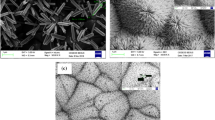Abstract
In this paper, the layers of quantum silicon nanowires produced on highly-doped wafers were studied via the Raman spectroscopy and IR reflection spectroscopy methods. The porosity of layers of different thickness has been determined from IR spectroscopy data using the Bruggeman effective medium model. According to Raman spectroscopy data, the concentration of the free charge carriers in quantum silicon nanowires drops in comparison with that in the wafer. On the basis of these results we conclude that the thickness of a quantum nanowires layer of 2 μm is optimal for its use as an antireflection coating in solar cells. Layers with thicknesses of 10 and 15 μm were studied. It was demonstrated that there is no effect of Raman-scattering enhancement in these layers.
Similar content being viewed by others
References
T. Saga, NPG Asia Mater. 2, 96 (2010). doi 10.1038/asiamat.2010.82
A. Gaucher, A. Cattoni, C. Dupuis, et al., Nano Lett. 16, 5358 (2016). doi 10.1021/acs.nanolett.6b01240
J. Oh, H.-C. Yuan, and H. M. Branz, Nat. Nanotechnol. 7, 743 (2012). doi 10.1038/nnano.2012.166
P. Spinelli, M. A. Verschuuren, and A. Polman, Nat. Commun. 3, 692 (2012). doi 10.1038/ncomms1691
Yu. Ukhanov, Optical Properties of Semiconductors (Nauka, Moscow, 1973).
D. A. G. Bruggeman, Ann. Phys. 24, 636 (1935).
F. Cerdeira, T. A. Fjeldly, and M. Cardona, Phys. Rev. B 9, 4344 (1974).
K. V. Bunkov, L. A. Golovan, and K. A. Gonchar, Semiconductors 47, 354 (2013).
M. A. Green and M. J. Keevers, Prog. Photovoltaics: Res. Appl. 3, 189 (1995).
I. H. Campbell and P. M. Fauchet, Solid State Commun. 58, 739 (1986).
L. A. Osminkina, E. V. Kurepina, A. V. Pavlikov, V. Yu. Timoshenko, and P. K. Kashkarov, Semiconductors 38, 581 (2004).
H. Tomioka and S. Adachi, ECS J. Solid State Sci. Technol. 2, 253 (2013). doi 10.1149/2.007306jss
A. Pavlikov, E. Konstantinova, and V. Timoshenko, Phys. Status Solidi C 8, 1928 (2011). doi 10.1002/pssc.201000088
Author information
Authors and Affiliations
Corresponding author
Additional information
Original Russian Text © A.V. Pavlikov, O.V. Rakhimova, P.K. Kashkarov, 2018, published in Vestnik Moskovskogo Universiteta, Seriya 3: Fizika, Astronomiya, 2018, No. 2, pp. 78–83.
About this article
Cite this article
Pavlikov, A.V., Rakhimova, O.V. & Kashkarov, P.K. Antireflection Layers for Solar Cells Based on Silicon Nanowires Produced on a Doped Wafer. Moscow Univ. Phys. 73, 199–204 (2018). https://doi.org/10.3103/S0027134918020121
Received:
Accepted:
Published:
Issue Date:
DOI: https://doi.org/10.3103/S0027134918020121




